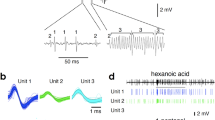Summary
-
1.
Neurons in the deutocerebrum ofPeriplaneta americana andLocusta migratoria respond to stimulation of the ipsilateral antenna by means of odours of chemicals and of homogenized food (grass, fruit, meat etc.).
-
2.
The morphological identification of the neurons investigated is attempted on the basis of anatomical data.
-
3.
InPeriplaneta most of these neurons manifest different reaction spectra. Frequent reactions were found to aliphatic alcohols, terpenes and essential oils (Tables 1, 2). Most reactions to lemon or orange were accompanied by reactions to certain characteristic odour substances (Table 3).
-
4.
InPeriplaneta, a comparison of the reaction spectra of deutocerebral units and those of antennal receptors (Table 4) leads to the following conclusions:
-
a)
There is a narrower specificity for fruit odours in individual central neurons than in the receptors.
-
b)
More compounds within a selected group of odours are effective upon central neurons than upon a single receptor type.
From these results it can be concluded that receptors of different odour specificity converge on single central neurons.
-
5.
Excitation reactions from receptors of different antennal regions converge on single central neurons (Fig. 4).
-
6.
InLocusta, central neurons react with excitation, inhibition, and off-responses to olfactory stimulation of the antenna (Fig.3). Their reaction spectra vary (Table 6).
-
7.
Inhibition inLocusta neurons is caused by receptor excitation rather than by receptor inhibition.
-
8.
The reaction spectra of central neurons ofLocusta permit the conclusion that these cells receive inputs from receptor cells in basiconic antennal sensilla. Whether the olfactory receptors in coeloconic sensilla play a role in these reactions is not clear (Table 6).
Zusammenfassung
-
1.
Neurone im Deutocerebrum vonPeriplaneta americana undLocusta migratoria antworten auf Beizung der ipsilateralen Antenne durch einzelne Duftstoffe und Homogenisate verschiedenen Futters (Gras, Früchte, Brot usf.).
-
2.
Eine anatomische Identifizierung der untersuchten Neurone wird versucht.
-
3.
Die Reaktionsspektren der Neurone vonPeriplaneta sind unterschiedlich; besonders häufig wirken aliphatische Alkohole, sowie einige Terpene, aromatische Verbindungen und ätherische Öle. Reaktionen auf Orangen- und Zitronengeruch sind häufig, aber nicht immer korreliert mit denen auf bestimmte Duftstoffe.
-
4.
BeiPeriplaneta zeigt ein Vergleich der Reaktionsspektren der zentralen Neurone mit denen der Rezeptoren
-
a)
eine engere Spezifität für Fruchtgerüche der zentrale Neurone,
-
b)
eine weniger enge Spezifität für bestimmte Geruchsstoffe bei zentralen Neuronen als bei einzelnen Rezeptortypen. Daraus kann auf eine Konvergenz der Erregung von Rezeptoren verschiedener Duftspezifität auf zentrale Neurone geschlossen werden.
-
5.
Die Erregung von Rezeptoren aus verschiedenen Antennenbereichen läuft auf zentralen Neuronen zusammen.
-
6.
Die Neurone vonLocusta reagieren auf Geruchsreizung der Antenne mit Erregung, Hemmung und off-Antworten. Die Reaktionsspektren sind nicht einheitlich.
-
7.
Die Hemmung der Neurone vonLocusta ist auf hemmend verschaltete Rezeptorerregung, nicht auf Rezeptorhemmung zurückzuführen.
-
8.
Ein Vergleich der Reaktionsspektren zentraler Neurone mit denen von antennalen Geruchsrezeptoren beiLocusta zeigt, daß die Rezeptoren aus basiconischen Sensillen maßgeblich die Erregung der zentralen Neurone bestimmen.
Similar content being viewed by others
Literatur
Boeckh, J.: Reaktionsschwelle, Arbeitsbereich und Spezifität eines Geruchsrezeptors auf der Heuschreckenantenne. Z. vergl. Physiol.55, 378–406 (1967)
Boeckh, J.: Die Reaktionen von Neuronen im Deutocerebrum der Wanderheuschrecke bei Duftreizung der Antennen. Verh. dtsch. zool. Ges. Mainz66, 180–193 (1972)
Boeckh, J., Sandri, C., Akert, K.: Sensorische Eingänge und synaptische Verbindungen im Zentralnervensystem von Insekten. Z. Zellforsch.103, 429–446 (1970)
Døving, K. B.: The influence of olfactory stimuli upon the activity of secondary neurons in the burbotLota lota L. Acta physiol. scand.66, 290–299 (1966)
Dumpert, K.: Alarmstoffrezeptoren auf der Antenne vonLasius fuliginosus (Latr.) (Hymenoptera, Formicidae). Z. vergl. Physiol.76, 403–425 (1972)
Gasser, H. S.: Olfactory nerve fibres. J. gen. Physiol.39, 473–496 (1956)
Gesteland, R. C.: Neural coding in olfactory receptor cells. In: Handbook of sensory physiology, H. Autrum, R. Jung, W. R. Loewenstein, D. M. MacKay, H. L. Teuber, eds., vol. IV: Chemical senses, part 1: Olfaction (L. M. Beidler, ed.), p. 132–150. Berlin-Heidelberg-New York: Springer 1971
Kafka, W. A.: Molekulare Wechselwirkungen bei der Erregung einzelner Biechzellen. Z. vergl. Physiol.70, 105–143 (1970)
Kaib, M.: Elektronenmikroskopische und elektrophysiologische Untersuchungen an Geruchsrezeptoren auf der Antenne der SchmeißfliegeCalliphora vicina (Rob.-Desvoid). Diss. nat.wiss. Fakultät Regensburg, 1973
Kaissling, K.-E.: Insect olfaction. In: Handbook of sensory physiology, H. Autrum, R. Jung, W. R. Loewenstein, D. M. MacKay, H. L. Teuber, eds., vol. IV: Chemical senses, part 1: Olfaction (L. M. Beidler, ed.), p. 351–431. Berlin- Heidelberg-New York: Springer 1971
Lambin, M.: Les sensilles de l'antenne chez quelques blattes et en particulier chezBlaberus craniifer (Burm.). Z. Zellforsch.143, 183–206 (1973)
Sass, H.: Das Zusammenspiel mehrerer Rezeptortypen bei der nervösen Codierung von Gerachsqualitäten. Verh. dtsch. zool. Ges. Mainz66, 198–201 (1972)
Sass, H.: Die Erregungsmuster antennaler Geruchsrezeptoren vonPeriplaneta americana bei Reizung mit Futterdüften und deren Inhaltsstoffen. Diss. nat.- wiss. Fakultät Regensburg 1974
Shepherd, G. M.: Synaptic organization of the mammalian olfactory bulb. Physiol. Rev.52, 864–917 (1972)
Slifer, E. H., Prestage, J. J., Beams, H.: The chemoreceptors and other sense organs on the antennal flagellum of the grasshopper (Orthoptera, Acrididae). J. Morph.105, 145–191 (1959)
Steinbrecht, R. A.: Comparative morphology of olfactory receptors. In: Olfaction and taste, III. C. Pfaffmann, ed., p. 1–21. New York: Rockefeller University Press 1969
Sydow, E. von, Westberg, M.: Flavour components in food. Göteborg: Svenska Institutet för Konservierings-forskning, 1962
Vareschi, E.: Duftunterscheidung bei der Honigbiene — Einzelzell-Ableitungen und Verhaltensreaktionen. Z. vergl. Physiol.75, 143–173 (1971)
Waldow, U.: Elektrophysiologische Untersuchungen an Feuchte-, Trocken- und Kälterezeptoren auf der Antenne der WanderheuschreckeLocusta. Z. vergl. Physiol.69, 249–283 (1970)
Waldow, U.: Elektrophysiologie eines neuen Aasgeruchrezeptors und seine Bedeutung für das Verhalten des Totengräbers (Necrophorus). J. comp. Physiol.83, 415–424 (1973)
Yamada, M.: Extracellular recording from single neurons in the olfactory centre of the cockroach. Nature (Lond.)217, 778–779 (1968)
Yamada, M.: A search for odour encoding in the olfactory lobe. J. Physiol. (Lond.)214, 127–143 (1971)
Author information
Authors and Affiliations
Additional information
Mit Unterstützung der Deutschen Forschungsgemeinschaft (Bo 343/2).
Rights and permissions
About this article
Cite this article
Boeckh, J. Die Reaktionen olfaktorischer Neurone im Deutocerebrum von Insekten im Vergleich zu den Antwortmustern der Geruchssinneszellen. J. Comp. Physiol. 90, 183–205 (1974). https://doi.org/10.1007/BF00694484
Received:
Issue Date:
DOI: https://doi.org/10.1007/BF00694484




